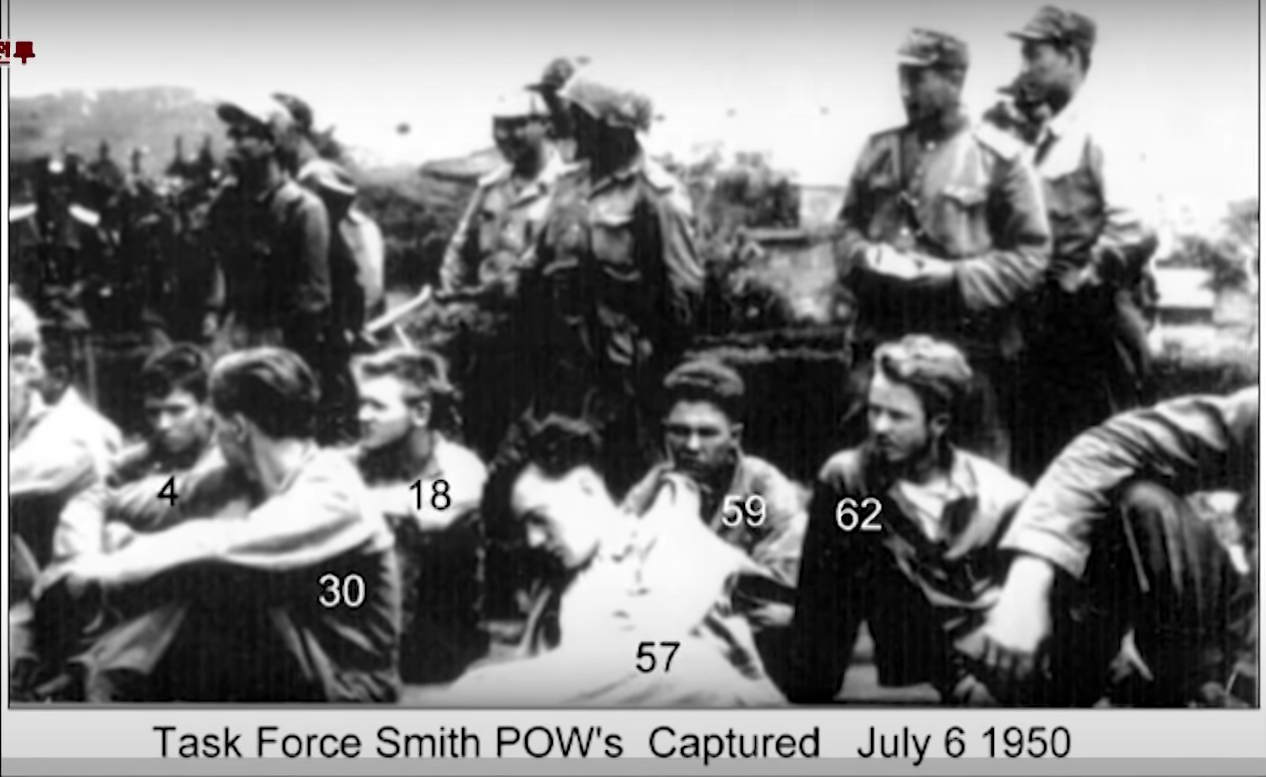 Did Americans Forget the Korean War?
Did Americans Forget the Korean War?
I felt embarrassed when I looked back at the awkward English conversation I had with Steve three years ago!😂
I guess Steve was probably curious as to what an awkward English-speaking East Asian like me was doing with his photos!😅
I posted his photo in my article because I felt that Steve looked similar to the American soldiers who fought in the Korean War 74 years ago.
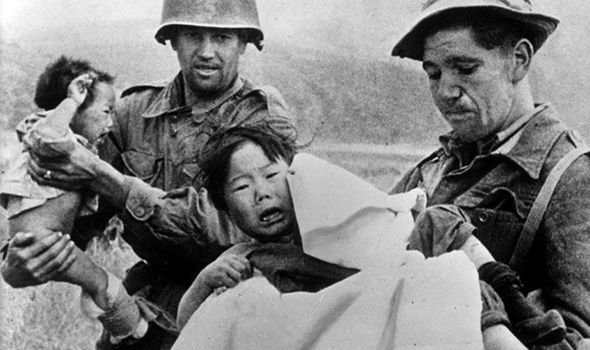 Korean war pictures Us soldiers take care of korean orphans
Korean war pictures Us soldiers take care of korean orphans
I imagined Steve's appearance and expression to be similar to those of American soldiers caring for orphans in Korea!
The scene of Korean orphan boys crying while being held by American soldiers is very tragic!
 A column of the U.S. 1st Marine Division's infantry and armor moves through Chinese lines during their breakout from the Chosin ReservoirExplosion during the Blockade of WonsanDamaged gate of the Hwaseong Fortress in SuwonA U.S. Fairchild C-119 Flying Boxcar flying near ChungjuKorean refugees in front of a U.S. M46 Patton tankUN landing at Inchon harbor, starting point of the Battle of Inchon
A column of the U.S. 1st Marine Division's infantry and armor moves through Chinese lines during their breakout from the Chosin ReservoirExplosion during the Blockade of WonsanDamaged gate of the Hwaseong Fortress in SuwonA U.S. Fairchild C-119 Flying Boxcar flying near ChungjuKorean refugees in front of a U.S. M46 Patton tankUN landing at Inchon harbor, starting point of the Battle of Inchon
The Korean War (25 June 1950 – 27 July 1953) was an armed conflict on the Korean Peninsula fought between North Korea (Democratic People's Republic of Korea; DPRK) and South Korea (Republic of Korea; ROK) and their allies. North Korea was supported by the People's Republic of China and the Soviet Union, while South Korea was supported by the United Nations Command (UNC) led by the United States.[d] Fighting ended in 1953 with an armistice, with no treaty signed.
After the end of World War II in 1945, Korea, which had been a Japanese colony for 35 years, was divided by the Soviet Union and the US into two occupation zones[e] at the 38th parallel, with plans for a future independent state. Due to political disagreements and influence from their backers, the zones formed their own governments in 1948. The DPRK was led by Kim Il Sung in Pyongyang, and the ROK by Syngman Rhee in Seoul; both claimed to be the sole legitimate government of all of Korea and engaged in limited battles. On 25 June 1950, the Korean People's Army (KPA), equipped and trained by the Soviets, launched an invasion of the south. In the absence of the Soviet Union,[d] the UN Security Council denounced the attack and recommended countries to repel the invasion.[36] UN forces comprised 21 countries, with the US providing around 90% of military personnel.[37][38]
After two months, the Republic of Korea Army (ROKA) and its allies were nearly defeated, holding onto only the Pusan Perimeter. In September 1950, however, UN forces landed at Inchon, cutting off KPA troops and supply lines. They invaded North Korea in October 1950 and advanced towards the Yalu River—the border with China. On 19 October 1950, the Chinese People's Volunteer Army (PVA) crossed the Yalu and entered the war.[39] UN forces retreated from North Korea in December, following the PVA's first and second offensive. Communist forces captured Seoul again in January 1951 before losing it two months later. Following the abortive Chinese spring offensive, they were pushed back to the 38th parallel, and the final two years of the fighting turned into a war of attrition.
The combat ended on 27 July 1953 when the Korean Armistice Agreement was signed, allowing the exchange of prisoners and creating the Korean Demilitarized Zone (DMZ). The conflict displaced millions of people, inflicting 3 million fatalities and a larger proportion of civilian deaths than World War II or the Vietnam War. Alleged war crimes include the killing of suspected communists by Seoul and the torture and starvation of prisoners of war by the North Koreans.[citation needed] North Korea became one of the most heavily bombed countries in history,[40] and virtually all of Korea's major cities were destroyed.[41] No peace treaty was ever signed, making the war a frozen conflict.[42][43]
The Korean War is a tragic event that will never be forgotten by Americans and Koreans.

My respected senior @valued-customer's father served in the US Navy in the Korean War.
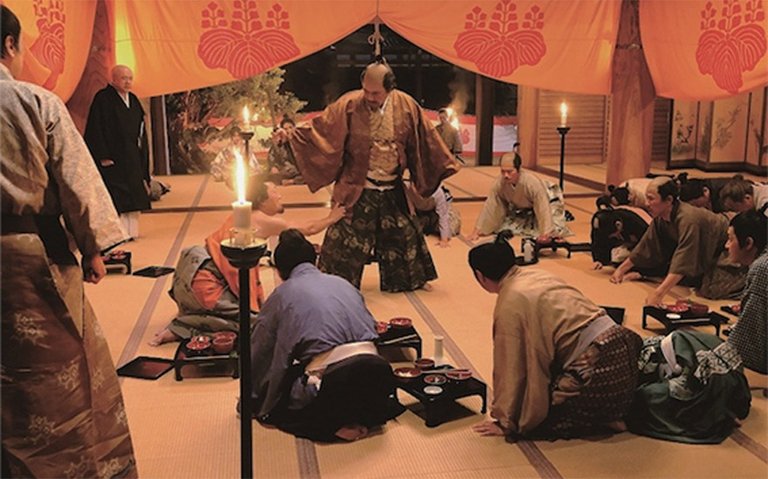
Japanese overlords
I'm worried that he might be offended by my comments about Americans' private lives!
I think that from an American perspective, the Korean War is a dishonorable war in American history that they would rather forget!
I hope my respected elder brother Steve and @valued-customer won't be offended by my claims!
I will state my argument from now on!
4. Why Japanese Fear America forever?
The Japanese overlords were gripped with fear and rage when @valued-customer appeared in Japan 160 years ago!
 A 1854 Japanese print depicting the Perry Expedition
A 1854 Japanese print depicting the Perry Expedition
The Perry Expedition (Japanese: 黒船来航, kurofune raikō, "Arrival of the Black Ships") was a diplomatic and military expedition in two separate voyages (1852–1853 and 1854–1855) to the Tokugawa shogunate (徳川幕府) by warships of the United States Naval corps. The goals of this expedition included exploration, surveying, and the establishment of diplomatic relations and negotiation of trade agreements with various nations of the region. Opening contact with the government of Japan was considered a top priority of the expedition, and was one of the key reasons for its inception.
The expedition was commanded by Commodore Matthew Calbraith Perry, under orders from President Millard Fillmore. Perry's primary goal was to force an end to Japan's 220-year-old policy of isolation and to open Japanese ports to American trade, through the use of gunboat diplomacy if necessary. The Perry Expedition led directly to the establishment of diplomatic relations between Japan and the western Great Powers, and eventually to the collapse of the ruling Tokugawa shogunate and the restoration of the Emperor. Following the expedition, Japan's burgeoning trade routes with the world led to the cultural trend of Japonisme, in which aspects of Japanese culture influenced art in Europe and America.
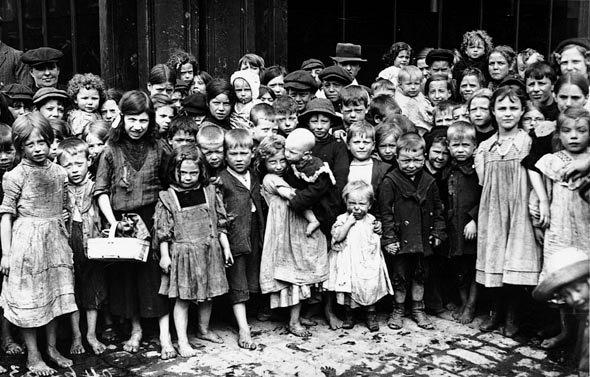
Children of the London Slums

America's rich natural environment and food
The Japanese overlords were shocked, horrified, and jealous when they saw the endless territory, food, and resources of the New World's civilians @valued-customer!😨
They were convinced that America was a far more fearsome enemy than all of Europe, including Britain!
They were terrified and angry that @valued-customer would conquer Japan in the future!
They were convinced that @valued-customer's religion, ideology, philosophy and beliefs were all the most dangerous things that could bring about the collapse of Japan!
They were ultimately convinced that they were destined to wage war with @valued-customer in the future.
However, Japan was a very poor and weak country compared to the United States. So, they were convinced that Japan should secure unlimited territory, population, and resources like the United States!
 Top to bottom:
Qing ship burning during the Battle of PungdoJapanese troops firing at Qing craft at the Battle of the Yalu RiverDepiction of Japanese cavalry attacking the Chinese army at the Battle of Pyongyang
Top to bottom:
Qing ship burning during the Battle of PungdoJapanese troops firing at Qing craft at the Battle of the Yalu RiverDepiction of Japanese cavalry attacking the Chinese army at the Battle of Pyongyang
The First Sino-Japanese War (25 July 1894 – 17 April 1895) or the First China–Japan War was a conflict between the Qing dynasty and the Empire of Japan primarily over influence in Korea.[2] After more than six months of unbroken successes by Japanese land and naval forces and the loss of the port of Weihaiwei, the Qing government sued for peace in February 1895 and signed the unequal Treaty of Shimonoseki two months later.
The war demonstrated the failure of the Qing dynasty's attempts to modernize its military and fend off threats to its sovereignty, especially when compared with Japan's successful Meiji Restoration. For the first time, regional dominance in East Asia shifted from China to Japan;[3] the prestige of the Qing dynasty, along with the classical tradition in China, suffered a major blow. The loss of Korea as a tributary state sparked an unprecedented public outcry[citation needed]. Within China, the defeat was a catalyst for a series of political upheavals led by Sun Yat-sen and Kang Youwei, culminating in the 1911 Revolution and ultimate end of dynastic rule in China.
The war is commonly known in China as the War of Jiawu (Chinese: 甲午戰爭; pinyin: Jiǎwǔ Zhànzhēng), referring to the year (1894) as named under the traditional sexagenary system of years. In Japan, it is called the Japan–Qing War (Japanese: 日清戦争, Hepburn: Nisshin sensō). In Korea, where much of the war took place, it is called the Qing–Japan War (Korean: 청일전쟁; Hanja: 淸日戰爭).
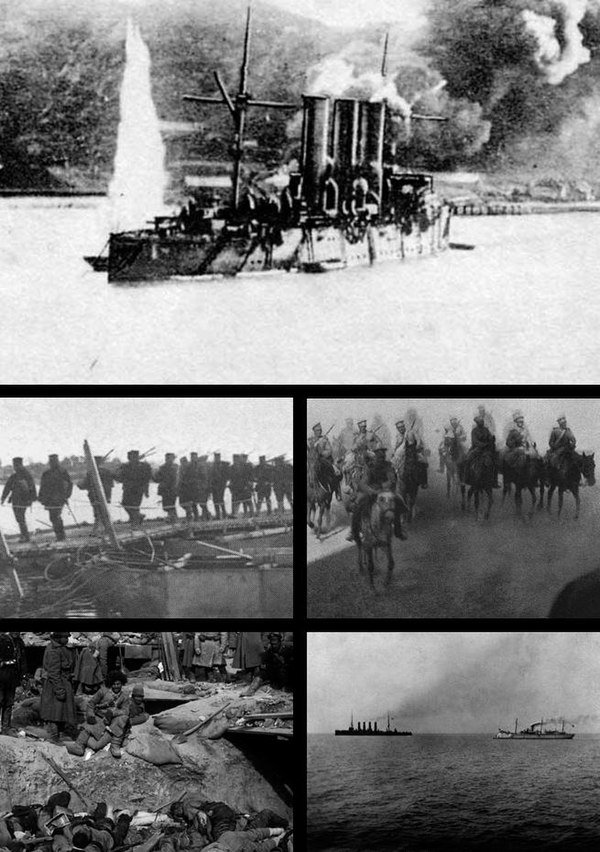 Clockwise from top: Russian cruiser Pallada under fire at Port Arthur, Russian cavalry at Mukden, Russian cruiser Varyag and gunboat Korietz at Chemulpo Bay, Japanese dead at Port Arthur, Japanese infantry crossing the Yalu River
Clockwise from top: Russian cruiser Pallada under fire at Port Arthur, Russian cavalry at Mukden, Russian cruiser Varyag and gunboat Korietz at Chemulpo Bay, Japanese dead at Port Arthur, Japanese infantry crossing the Yalu River
The Russo-Japanese War was fought between the Russian Empire and the Empire of Japan during 1904 and 1905 over rival imperial ambitions in Manchuria and the Korean Empire.[4] The major theatres of military operations were in the Liaodong Peninsula and Mukden in Southern Manchuria, the Yellow Sea and the Sea of Japan.
Russia sought a warm-water port on the Pacific Ocean both for its navy and for maritime trade. Vladivostok remained ice-free and operational only during the summer; Port Arthur, a naval base in Liaodong Province leased to Russia by the Qing dynasty of China from 1897, was operational year round.
Russia had pursued an expansionist policy east of the Urals, in Siberia and the Far East, since the reign of Ivan the Terrible in the 16th century.[5] Since the end of the First Sino-Japanese War in 1895, Japan had feared Russian encroachment would interfere with its plans to establish a sphere of influence in Korea and Manchuria. Seeing Russia as a rival, Japan offered to recognize Russian dominance in Manchuria in exchange for recognition of the Korean Empire as being within the Japanese sphere of influence. Russia refused and demanded the establishment of a neutral buffer zone between Russia and Japan in Korea, north of the 39th parallel. The Imperial Japanese Government perceived this as obstructing their plans for expansion into mainland Asia and chose to go to war. After negotiations broke down in 1904, the Imperial Japanese Navy opened hostilities in a surprise attack on the Russian Eastern Fleet at Port Arthur, China, on 9 February [O.S. 27 January] 1904. The Russian Empire responded by declaring war on Japan.
Although Russia suffered a number of defeats, Emperor Nicholas II remained convinced that Russia could still win if it fought on; he chose to remain engaged in the war and await the outcomes of key naval battles. As hope of victory dissipated, he continued the war to preserve the dignity of Russia by averting a "humiliating peace". Russia ignored Japan's willingness early on to agree to an armistice and rejected the idea of bringing the dispute to the Permanent Court of Arbitration at the Hague. After the decisive naval battle of Tsushima, the war was concluded with the Treaty of Portsmouth (5 September [O.S. 23 August] 1905), mediated by US President Theodore Roosevelt. The complete victory of the Japanese military surprised international observers and transformed the balance of power in both East Asia and Europe, resulting in Japan's emergence as a great power and a decline in the Russian Empire's prestige and influence in Europe. Russia's incurrence of substantial casualties and losses for a cause that resulted in humiliating defeat contributed to growing domestic unrest, which culminated in the 1905 Russian Revolution, and severely damaged the prestige of the Russian autocracy.
In order to conquer the continent, Japan had to first wage war against China and Russia.
Although China and Russia were larger continental empires than Japan, Japan's overlords were convinced that they were weaker enemies than @valued-customer.😆
China and Russia were Japan's War training opponent before going to war with @valued-customer.🤣
In the end, as the Japanese overlords had expected, Japan won the war against China and Russia!
From 1910 to 1945, Korea was ruled as a part of the Empire of Japan under the name Chōsen (Japanese: 朝鮮), the Japanese reading of Joseon.[a]
Japan first took Korea into its sphere of influence during the late 1800s. Both Korea (Joseon) and Japan had been under policies of isolationism, with Joseon being a tributary state of Qing China. However, in 1854, Japan was forcefully opened by the United States in the Perry Expedition. It then rapidly modernized under the Meiji Restoration, while Joseon continued to resist foreign attempts to open it up. Japan eventually succeeded in opening Joseon with the unequal Japan–Korea Treaty of 1876.
Afterwards, Japan embarked on a decades-long process of defeating its local rivals, securing alliances with Western powers, and asserting its influence in Korea. Japan assassinated the defiant Korean queen and intervened in the Donghak Peasant Revolution.[10][11] After Japan defeated China in the 1894–1895 First Sino–Japanese War, Joseon became nominally independent and declared the short-lived Korean Empire. Japan then defeated Russia in the 1904–1905 Russo-Japanese War, making it the sole regional power. It then moved quickly to fully absorb Korea. It first made Korea a protectorate with the Japan–Korea Treaty of 1905, and then ruled the country indirectly through the Japanese Resident-General of Korea. After forcing the Korean Emperor Gojong to abdicate in 1907, Japan then formally colonized Korea with the Japan–Korea Treaty of 1910. The territory was then administered by the Governor-General of Chōsen, based in Keijō (Seoul), until the end of the colonial period.
Japan, having won the war against China and Russia, annexed Korea.
After annexing Korea, Japan's overlords were overcome with arrogance and enthusiasm at the prospect of seizing the opportunity to conquer the continent.
They guessed that the next war they would wage against was @valued-customer, after China and Russia!
 Syngman Rhee
이승만
Syngman Rhee
이승만
Syngman Rhee (Korean: 이승만; Hanja: 李承晚, pronounced [iː.sɯŋ.man];[c] 26 March 1875 – 19 July 1965) was a South Korean politician who served as the first president of South Korea from 1948 to 1960. Rhee is also known by his art name Unam (우남; 雩南).[1] Rhee was also the first and last president of the Provisional Government of the Republic of Korea from 1919 to his impeachment in 1925 and from 1947 to 1948. As president of South Korea, Rhee's government was characterised by authoritarianism, limited economic development, and in the late 1950s growing political instability and public opposition.
Born in Hwanghae Province, Joseon, Rhee attended an American Methodist school, where he converted to Christianity. He became a Korean independence activist and was imprisoned for his activities in 1899. After his release in 1904, he moved to the United States, where he obtained degrees from American universities and met President Theodore Roosevelt. After a brief 1910–12 return to Korea, he moved to Hawaii in 1913. In 1919, following the Japanese suppression of the March 1st Movement, Rhee joined the right-leaning Korean Provisional Government in exile in Shanghai. From 1918 to 1924, he served as the first President of the Korean Provisional Government until he was impeached in 1925. He then returned to the United States, where he advocated and fundraised for Korean independence. In 1939, he moved to Washington, DC. In 1945, he was returned to US-controlled Korea by the US military, and on 20 July 1948 he was elected the first president of the Republic of Korea by the National Assembly, ushering in the First Republic of Korea.
Syngman Rhee, a Christian and member of Korean royalty, was convinced that Japan would wage war with the United States in the future.
He believed that Koreans, suffering under Japan's harsh rule, would gain independence with American help.
He believed that the Christian empire of the United States and the polytheistic empire of Japan were destined to go to war in the future!
He was convinced that the citizen @valued-customer and the Japanese overlords could never coexist peacefully.😆
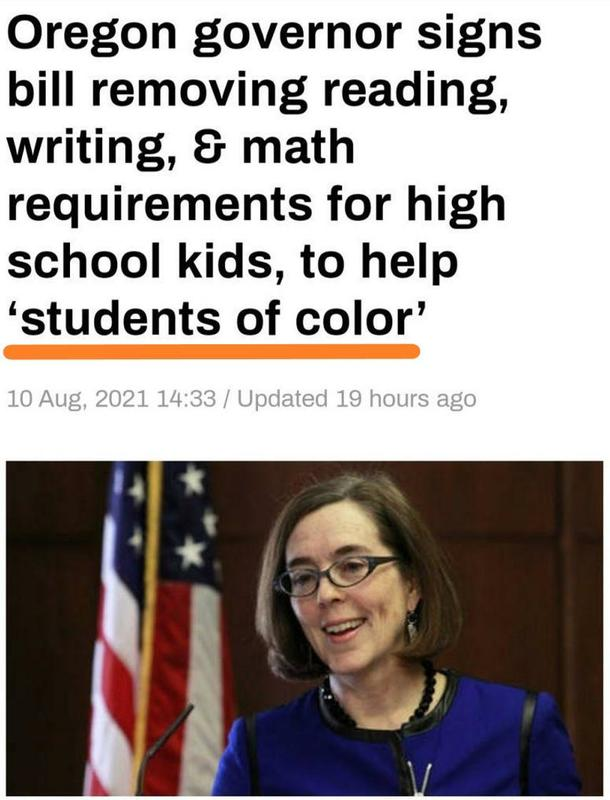
Mrs. Kate Brown
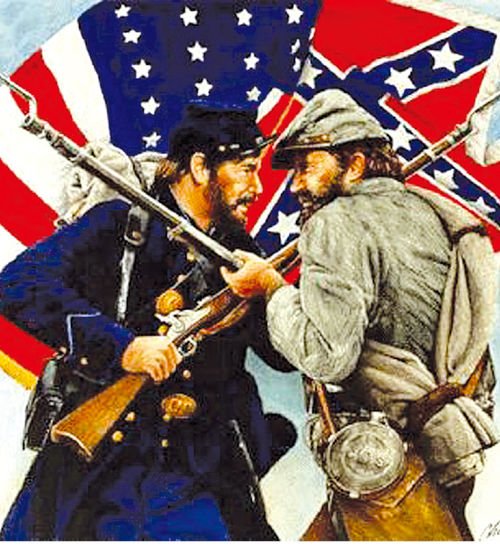
I absolutely agree with Syngman Rhee's assertion, seeing Mrs. Kate Brown, who has received the unwavering trust and love of my dear @valued-customer!😆
After that, he asked @valued-customer to help Korea gain independence!
 Imperial Japanese Navy landing force in military gas masks in the Battle of ShanghaiNational Revolutionary Army fighting in Great WallVictims of the Nanjing Massacre on the shore of the Qinhuai RiverChinese machine gun nest in the Battle of WuhanJapanese Mitsubishi Ki-21 bomber during the bombing of ChongqingChinese Expeditionary Force marching in India
Imperial Japanese Navy landing force in military gas masks in the Battle of ShanghaiNational Revolutionary Army fighting in Great WallVictims of the Nanjing Massacre on the shore of the Qinhuai RiverChinese machine gun nest in the Battle of WuhanJapanese Mitsubishi Ki-21 bomber during the bombing of ChongqingChinese Expeditionary Force marching in India
The Second Sino-Japanese War was fought between the Republic of China and the Empire of Japan between 1937 and 1945, following a period of war localized to Manchuria that started in 1931.[24][25] It is considered part of World War II, and often regarded as the beginning of World War II in Asia. It was the largest Asian war in the 20th century[26] and has been described as "the Asian Holocaust", in reference to the scale of Japanese war crimes against Chinese civilians.[27][28][29] It is known in China as the War of Resistance against Japanese Aggression (simplified Chinese: 抗日战争; traditional Chinese: 抗日戰爭).
When Japan started the Second Sino-Japanese War to conquer China, Syngman Rhee was convinced that Japan would soon attack the United States!
Syngman Rhee argued that after Japan conquered China, it would immediately attack the United States.
He claimed that if American troops landed in Tokyo Bay, Japan could be quickly conquered.
He argued that the United States should conquer Japan while Japan was at war with China.
However, @valued-customer rejected Syngman Rhee's claim because of hiself excessive pride and arrogance! He thought that a country like Japan would not dare to attack the United States.
 Photograph of Battleship Row taken from a Japanese plane at the beginning of the attack. The explosion in the center is a torpedo strike on USS West Virginia. Two attacking Japanese planes can be seen: one over USS Neosho and one over the Naval Yard.
Photograph of Battleship Row taken from a Japanese plane at the beginning of the attack. The explosion in the center is a torpedo strike on USS West Virginia. Two attacking Japanese planes can be seen: one over USS Neosho and one over the Naval Yard.
The attack on Pearl Harbor[nb 3] was a surprise military strike by the Imperial Japanese Navy Air Service on the American naval base at Pearl Harbor in Honolulu, Hawaii, in the United States, just before 8:00 a.m. (local time) on Sunday, December 7, 1941. At the time, the United States was a neutral country in World War II. The attack on Hawaii and other U.S. territories led the United States to formally enter World War II on the side of the Allies the day following the attack, on December 8, 1941. The Japanese military leadership referred to the attack as the Hawaii Operation and Operation AI,[nb 4] and as Operation Z during its planning.[14][15][16]
The United States, which ignored Syngman Rhee's claims, was attacked by Japan and suffered great damage.
How would history have changed if the United States had accepted Syngman Rhee's claims?
Americans suffered half a million dead and missing in World War II.
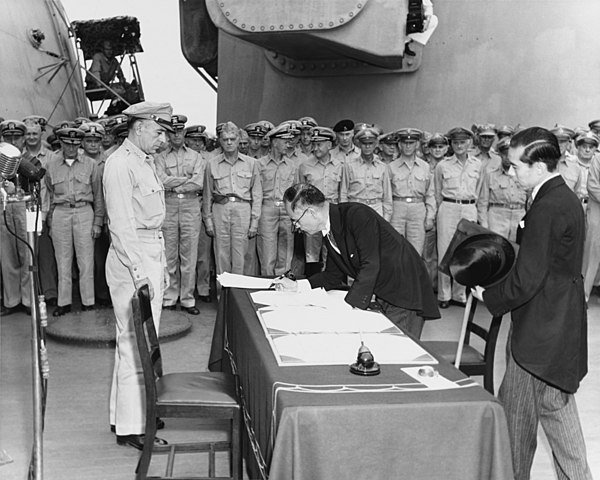 Japanese foreign affairs minister Mamoru Shigemitsu signs the Japanese Instrument of Surrender aboard the USS Missouri as American General Richard K. Sutherland watches, 2 September 1945.
Japanese foreign affairs minister Mamoru Shigemitsu signs the Japanese Instrument of Surrender aboard the USS Missouri as American General Richard K. Sutherland watches, 2 September 1945.
The surrender of the Empire of Japan in World War II was announced by Emperor Hirohito on 15 August and formally signed on 2 September 1945, ending the war. By the end of July 1945, the Imperial Japanese Navy (IJN) was incapable of conducting major operations and an Allied invasion of Japan was imminent. Together with the United Kingdom and China, the United States called for the unconditional surrender of Japan in the Potsdam Declaration on 26 July 1945—the alternative being "prompt and utter destruction". While publicly stating their intent to fight on to the bitter end, Japan's leaders (the Supreme Council for the Direction of the War, also known as the "Big Six") were privately making entreaties to the publicly neutral Soviet Union to mediate peace on terms more favorable to the Japanese. While maintaining a sufficient level of diplomatic engagement with the Japanese to give them the impression they might be willing to mediate, the Soviets were covertly preparing to attack Japanese forces in Manchuria and Korea (in addition to South Sakhalin and the Kuril Islands) in fulfillment of promises they had secretly made to the US and the UK at the Tehran and Yalta Conferences.
 American soldiers in Korea
American soldiers in Korea
The National Liberation Day of Korea is a public holiday celebrated annually on 15 August in both South and North Korea. It commemorates the day when Korea was liberated from 35 years of Japanese colonial rule by the Allies in 1945. The day also coincides with the anniversary of the founding of South Korea in 1945.[1]
Korea gained independence when Japan surrendered to the United States. However, a new tragedy began when Soviet troops entered the Korean Peninsula.
The Soviet Union hoped to gain the upper hand in a new war with the United States by occupying the Korean Peninsula.
 Closeup of the Korean Demilitarized Zone that surrounds the Military Demarcation Line
Closeup of the Korean Demilitarized Zone that surrounds the Military Demarcation Line
The division of Korea began on August 15, 1945 when the official announcement of the surrender of Japan was released, thus ending the Pacific Theater of World War II. During the war, the Allied leaders had already been considering the question of Korea's future following Japan's eventual surrender in the war. The leaders reached an understanding that Korea would be liberated from Japan but would be placed under an international trusteeship until the Koreans would be deemed ready for self-rule.[1] In the last days of the war, the United States proposed dividing the Korean peninsula into two occupation zones (a U.S. and Soviet one) with the 38th parallel as the dividing line. The Soviets accepted their proposal and agreed to divide Korea.[2]
Syngman Rhee became the president of the liberated Korea. He insisted that the United States should immediately attack North Korea and dominate the entire Korean Peninsula. He argued that by dominating the entire Korean Peninsula, the United States could gain hegemony in East Asia.
However, the United States rejected his claim because it did not want Americans to die in the Korean War.
 Mao Zedong proclaiming the foundation of the People's Republic of China on October 1, 1949
Mao Zedong proclaiming the foundation of the People's Republic of China on October 1, 1949
The proclamation of the People's Republic of China was made by Mao Zedong, the Chairman of the Chinese Communist Party (CCP), on October 1, 1949, in Tiananmen Square in Beijing. The government of a new state under the CCP, formally called the Central People's Government, was proclaimed by Mao at the ceremony, which marked the foundation of the People's Republic of China.
The United States stood by as Mao Zedong communized mainland China in 1949. However, Syngman Rhee predicted that the fact that China followed in the footsteps of the Soviet Union and became communist was an extremely dangerous situation for the United States.
Syngman Rhee argued that the fact that the world's two largest continental empires, the Soviet Union and China, had become communist was extremely dangerous for the United States. He immediately called for the United States to conquer North Korea and dominate the entire Korean Peninsula.
However, @valued-customer again rejected his claim, believing that China would not dare to attack the US.
@valued-customer mistakenly believed that Mao Zedong was a trustworthy pro-American.
However, Syngman Rhee argued that Mao Zedong could never be trusted.
He claimed that if America trusted Mao Zedong, it would surely regret it in the future!
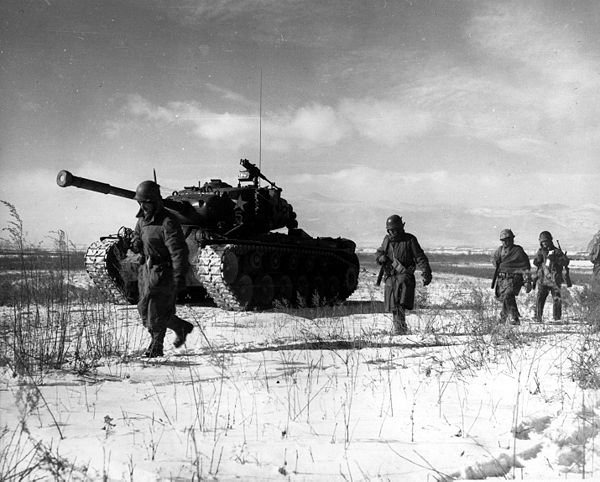 A column of the US 1st Marine Division moves through Chinese lines during its breakout from the Chosin Reservoir with a M46 Patton medium tank.
A column of the US 1st Marine Division moves through Chinese lines during its breakout from the Chosin Reservoir with a M46 Patton medium tank.
The Battle of Chosin Reservoir, also known as the Chosin Reservoir Campaign or the Battle of Lake Changjin (Korean: 장진호 전투; Hanja: 長津湖戰鬪; RR: Jangjinho jeontu; MR: Changjinho chŏnt'u), was an important battle in the Korean War.[c] The name "Chosin" is derived from the Japanese pronunciation "Chōshin", instead of the Korean pronunciation.[9][10][d]
The battle took place about a month after the People's Republic of China entered the conflict and sent the People's Volunteer Army (PVA) 9th Corps[e] to infiltrate the northeastern part of North Korea. On 27 November 1950, the Chinese force surprised the US X Corps commanded by Major General Edward Almond in the Chosin Reservoir area. A brutal 17-day battle in freezing weather soon followed. Between 27 November and 13 December, 30,000[1] United Nations Command troops, later nicknamed "The Chosin Few", under the field command of Major General Oliver P. Smith were encircled and attacked by about 120,000[2] Chinese troops under the command of Song Shilun, who had been ordered by Mao Zedong to destroy the UN forces.
The UN forces were nevertheless able to break out of the encirclement and withdraw to the port of Hungnam. Both sides suffered heavy casualties, especially the Chinese, with both battle casualties and non-battle casualties caused by the frigid weather. The withdrawal of the US Eighth Army from northwest Korea in the aftermath of the Battle of the Ch'ongch'on River and the evacuation of the X Corps from the port of Hungnam in northeast Korea marked the complete withdrawal of UN troops from North Korea.
The Chinese claim that the Battle of Chosin Reservoir was a great victory for the Chinese army over the American army.🤣
I wonder what the current situation would have been like if the US had accepted Syngman Rhee's argument and ruled the entire Korean Peninsula!
Disclaimer I would like to first state that the above article is entirely my personal research and critique, so there is a possibility of misunderstandings and errors.
My respected elder brother Steve always adviced me about the possibility that my awkward English could lead to misunderstanding, discontent and discomfort from the public.😅
I especially hope that my respected seniors will not be offended by American elementary school student's rude and barbaric English!😆

I found your use of the barbaric tongue of the English of exceptionally high quality, and your presentation of historic material highly educational.
Thanks!
Dear @valued-customer !
I always appreciate your excessive compliments! However, I always worry that Steve will be disappointed by my rude and barbaric English!😂
He is busy with his business these days and doesn't have time to talk to me.
I guess he probably wants you to teach me the manners and etiquette of an American gentleman!😆
I made the foolish assumption that he was worried that if he talked to a barbarian like me, he would be looked down on by other Americans!😆
conann! What is the best in life?
To crush your enemies, see them driven before you, and hear the pleasure of their women when you take them.
Screw lamentations. I like to make them happy they get me instead of the losers I rid them of.
Dear @valued-customer !
If Russia, China, and Japan invade America, I believe you will become a barbarian like Conan!😄
I believe I'll quickly become dead, but that will achieve my life's goal of dying in battle and thereafter feasting in Valhalla with my esteemed ancestors.